| Home -> Other California History Books -> The People's Eee Zee Guide of the Panama-Pacific International Exposition and Mysteries of the Zone - Text | |||
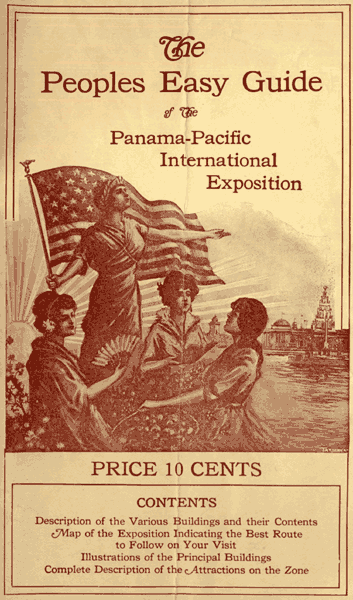 |
|||
|
The People's Eee Zee Guide
of the Panama-Pacific International Exposition and Mysteries of the Zone The Exposition To commemorate the greatest achievement of mankind in the Western Hemisphere, the building of the Panama Canal, the people and the government of the United States of America some four years ago conceived the stupendous plan of building on the littoral of San Francisco's far-famed bay the greatest International Exposition the world has seen. Thus San Francisco was crowned with the laurels so eagerly sought by many another metropolis of the seas. With characteristic promptness the first earth was broken for the great undertaking a few months after the documents proclaiming the Exposition had left the President's offices in Washington, and today expert opinion, viewing the Exposition, is agreed that the object of commemorating the wedding of the oceans could not have been attained more worthily or more fittingly. Great praise above all other for bringing about this immense work, is due to the citizens and the city fathers of San Francisco. Today a newer and greater San Francisco stands ready for inspection by the world, and more particularly by those other Americans of the North and the South and the East and the West, who, arriving in this land of romance and beauty, find that not only has the Phoenix risen from her ashes, but that in the heart of the rebuilt city there today stands the Panama-Pacific International Exposition, which, in the mind of the architect, the artist, the professional expositionist, and last, but not least, in the mind of the plain citizen, is the last word in beauty and high conception. Some six hundred acres of land stretching from the heart of San Francisco to the foot of the famed Presidio Heights contain treasures brought from the ends of the earth. The general scheme of the layout is a long oblong which may be divided in three sections. The first of these comprises in its central part those monuments of art, the main exposition palaces, twelve in all. The second section on the left and western end has a great number of State Buildings and Pavilions of foreign nations, and the third section at the right or eastern end contains a collection of amusements and attractions which is to go down in history as the "Zone." More wondrous than the dreams of the Khalifs of old, will be the scene when illuminated by a marvelous and never-before-tried system of indirect or concealed lighting. The extraordinary mild climate of California, rivaling that of France's scintillating Riviera, has made possible the use of the wonders of the forest in the decorative system. Next to the fir of the Northland there grow in the shadow of mighty walls the spreading palm of romance and the exotic flower of the Orient. A Hint to Visitors We would strongly advise visitors who desire to see as much as possible of the Exposition with the minimum amount of time and fatigue, to start their tour of the Exposition by making direct for the Machinery Hall, which is adjacent to the Fillmore Street entrance of the Exposition, and to the right of all other entrances, with the exception of that of Van Ness Avenue, situated at the extreme end of the "Zone." A short walk to this building upon entering the Exposition protects the visitor from the annoyance and fatigue of retracing his steps frequently in seeing the wonders of the jewel City. The Machinery Hall is situated on the Avenue of Progress; the building itself is the largest of the Exposition Palaces. Its size will be realized when it is remembered that America's foremost aviator, the daring Beachy of looping-the-loop fame, actually rose to flight within the building and successfully accomplished his unique trip within the Hall. The Machinery Hall The Machinery Hall is recognized by a series of tall ornamental columns, each surmounted by a figure typical of strength and material progress. Upon entering the building the first display noted is that of the Standard Gas Company, showing in actual working various types of gas engines and machines. Turning to our right to explore that portion of the building first, we find the exhibits of the National Meter Company, where the visitor sees the secret workings of the interior of various liquid meters. Continuing along this aisle past various smaller exhibits, we come to the interesting display of the Burger and Carthy Company, showing machines utilized in the fruit preserving industry. Little do we realize when opening a can of the many preserved foods, that make up the modern diet, what huge machinery is employed to hygienically prepare and put-up these sterling foods. At the end of the aisle, turning to our left and retracing the building through the next aisle, we find a series of displays comprising machine-tools, laths and pumps. The display of the Rialto Engineering Construction Company comprises not only a showing of their various-sized pumps, but this firm has constructed a waterfall fed by one of their up-to-date pumping installations; in fact, in this section of the Machinery Hall is noticed a display of various smaller class machines; toward the back of the building at this end, working exhibits of various conveyors are found, as well as an exhaustive collection of machines for road building and grading. Pile drivers, concrete mixers, steam rollers, and suchlike machines are there in abundance. Passing across the Machinery Hall at the back, we arrive at the printing trade section, notably the great display of the San Francisco "Examiner," which gives the many millions of visitors an opportunity of seeing how a newspaper comes into being. Linotypes for setting up type, colored block processes and other machinery are actually printing, cutting and folding in full view of the awed spectator. This exhibit is on an unprecedented scale, and forms a main feature of the great building. Passing to the front of the building we arrive at a collection of electrical exhibits, including motors, cables, electric wiring, etc. The most comprehensive display in this section has been made by the Westinghouse Allied Manufacturing Companies, and includes a most complete collection of electrical appliances. The remainder of the Machinery Hall, about one-fourth, is occupied by an elaborate display of the United States Army and Navy departments. Here is a mass of most interesting exhibits, which should all be carefully inspected. The visitor will find a true to scale working model of a harbor with its fortifications and mines. A tiny boat upon real water will be shown coming into contact with these mines, and, in a miniature way, blown up and sunk. A complete factory of small arms and ammunition, in thorough working condition, is also shown. Nearby a collection of the various rifles used in the United States Army during various periods is displayed. An interesting exhibit of models showing Army uniforms of the past and present is included. Having exhausted the study of this great building we next visit the palace devoted to Mines and Metallurgy This is the building to the right of the spectator as he stands with his back turned to the Machinery Hall. It faces the Bay of San Francisco. Entering the central door of the building we find on our left displays by various manufacturers, including one of the Standard Oil Company, the American Coal Products Company, and a magnificent display occupying a greater portion of the building, by the United States Steel Company, and the various allied companies of this great corporation. The exhibit is a most interesting one and should be carefully inspected. Passing through these exhibits, we will find a hall where moving pictures will be shown in connection with the Steel Company's industry. Continuing in the same direction, we arrive in a section devoted to exhibits of the various life insurance companies. Statistics and other interesting data of the Prudential Company, Metropolitan Life Insurance Company and others, appeal to those interested in this particular subject. Returning along the main aisle we find some interesting and elaborate individual exhibits, including that of the W. P. Fuller and the New York Lime companies. A reminder of the comprehensiveness and scope of the Exposition is found in a display of mining by Japan. Close to this is the most important exhibit in the building, briefly known as the "Mine." It is, in reality, a composite mine, and includes a subterranean reproduction of typical sections of the various mines of America. The visitor descends a shaft, and then is given a small lantern and permitted to explore the wonders of this nether realm. Here we see sections of a gold mine as the industry exists at present, but the mine is not limited to any particular minerals or substances, for in another section we suddenly find ourselves in a coal mine. The atmosphere and workings have completely changed and once again examining the wonders of our new surroundings we find another field of interest, for apparently we have entered a tin mine. And so the underground caverns are entered with increasing interest and the visitor unconsciously assimilates knowledge by this most instructive display. On returning to the surface once more we visit next the display made by the United States Government Post Office Department and the Treasury, and here find a mass of detail connected with postal work never before realized by the casual visitor. Leaving this building at the end opposite to where entered, we find ourselves in a handsome court which architecturally has the appearance of an immense organ. Turning to our left we pass under a large archway into the Court of Abundance, and feast our eyes upon its beauties. We cross to our right through the Court of the Rising Sun and enter the building at our right hand, namely The Transportation Palace Entering this building, we find facing us and marking the center of the Transportation Building, a huge elevated turn-table upon which stands a full size electric engine, displayed by the Westinghouse Brake Company. The one-half of the building on our right has been given over entirely to various exhibits of road transportation, mostly of course, to the automobile. This section is divided into a series of courts, the most novel features of which are great relief panoramic friezes showing road routes of various parts of the country and lending a most attractive and striking effect. The left portion of the building nearest to the visitor is occupied by displays of steamship companies, including exhibits of Japanese steamship lines; while the remainder of the building is devoted to railway transportation, showing various full sized trains, cars and other railroad equipment, including moving picture shows in Pennsylvania Railroad cars. Also there stands a striking exhibit of the Wells Fargo Company picturing the old fashioned stage coach, comparing the methods and inconveniences of travel in the olden days with the luxury and ease the traveler enjoys today. Leaving the Transportation Palace we visit The Court of the Universe At the head of which stands the Tower of Jewels, the predominate feature of the Exposition. When standing in the center of the court, facing the beautiful tower to our left, we find a handsome arch, surmounted by a group of heroic statuary picturing the nations of the East, while to our right the court is bounded by a similar arch surmounted by a group representing the nations of the West, The Court itself is most awe-inspiring and has a solemn and elevating atmosphere, the peace of which is only broken by the clattering of the waters of two handsome fountain pillars. We can now proceed to the Court of the Setting Sun and enter The Agriculture Palace On our right. Having entered, directly on our right is a series of handsome exhibits by various States of the Union, the most prominent of which are those of Illinois, Missouri and Idaho. Having inspected the various agricultural products of the different States displayed, we come upon a section of the building devoted to a great display by the International Harvester Company. Here hundreds of machines used in the agriculture industry will be found, including the reapers, plows, sowers, and even traction engines. Then, having exhausted the displays on the right, we next arrive at the exhibits from countries across the seas. Manila and Puerto Rico have installed most picturesque and charming exhibits, while that of Japan and China must claim our admiration. Finally, turning toward the doorway from which we entered, but to the left side, we find Uruguay and New Zealand side by side, their fine exhibits emphasizing the importance of the agricultural industry. So closely allied to agriculture is food, that upon leaving this building and crossing the Court of the Four Seasons, we enter The Palace of Food Products In this building again Japan has been ahead of foreign nations with her display; while of the various large corporations of our own country who have entered this section, we think the best display has been made by the Sperry Flour Company, showing a huge flour mill in full operation. A beautiful erection of a vineyard by the California Viticulture Association; a pronounced exhibit of the H. J. Heinz Co., showing a tower built of its fifty-seven varieties, are also special features, while the smaller exhibit of the Seattle Malting and Brewing Company of the Rainier Beer claim the admiration of all. Leaving this palace and passing out toward the Bay of San Francisco we find ourselves facing the great building erected by the State of California. The building itself is in old mission style, with an abundance of mission bells embodied in its architecture, while the building itself is surrounded by a multitude of palms, trees, flowers and other plants, including some fine specimens of cactus. The interior of the building will show the visitor that the State of California is fully contributing its share to the maintenance of the industrial and commercial supremacy of the United States. Leaving this building, we should next take in the small square pavilion of the Hawaiian Islands, which takes us but a few moments, and thence proceed to The Palace of Fine Arts At the head of the beautiful lagoon, with its ornamental colonnades and abundance of statuary. The Fine Arts Palace is a fitting home for the great paintings which have been carried over the Seven Seas to the City of the Golden Gates. Of the modern schools of painting the American, French, Dutch and Swedish schools are represented by masterpieces worth millions in all. Foreign and State Buildings We have now completed our inspection of six of the twelve large exhibit palaces and will give our attention to the inspection of the various smaller exhibit pavilions of foreign countries and our own States. Passing along the main avenue by the road on our left, we visit in rotation Netherlands, then the Argentine, China and finally Canada, the exterior architecture of each being typical of the nations who are making the displays therein. Canada is by far the largest of these pavilions and likewise contains the most comprehensive display. Here the industries for which Canada is famous are represented, as well as its natural resources. Before proceeding to other foreign displays and visiting the buildings systematically, we must visit some of the State pavilions, the first of which is adjacent to Canada, namely Indiana. Most of the state pavilions are a series of reception halls containing some interesting displays and are intended to welcome their respective citizens. We pass back now in the direction from which we started and toward the Netherlands building, from state building to state building, as follows: Utah, Ohio and Illinois, and we arrive at a building not of a state, but of a city - namely, New York. Proceeding along, we come to the Pennsylvania Building, which is a replica of Independence Hall of Philadelphia. Thence we enter the large building of the State of New York, and then pass around the Oregon Building, easily recognized by its construction of immense logs. We once more reverse our direction and proceed along a new chain of buildings back of those already seen, taking in the buildings of New Jersey, Wisconsin (the famous grain and stock state), Nevada and its great mineral resources, Mississippi, Idaho and Virginia, the latter building being a reproduction of the home of George Washington at Mt. Vernon. We now find ourselves in a large open square fronted by the Massachusetts Building with its gilded Dome. This building faces the main Exposition avenue, running from Machinery Hall, parallel with the Bay. We will make a loop of this building, and turning to the avenue on our right we visit Iowa, Mississippi and Texas, the largest State of the Union, on the left of the avenue; and North Dakota, Kansas, West Virginia and Arkansas on the right. We have now arrived at the Live Stock Exhibit. After visiting various stalls occupied by the live stock, we leave the Bay side for the avenue on the other side of the ground, being now on our return trip. We do not meet anything particularly striking until we again reach the Massachusetts building. Keeping toward our right we come to the building of the Philippine Islands, which although small in height, is of considerable area and comprises a most interesting display, typical of the Islands. Continuing our course we enter Sweden, then Bolivia, facing which is the building to be occupied by the Army Club. Continuing along the same avenue we inspect on our left the small building of Turkey with its four green domes alongside of a group of handsome buildings erected to house the display of Italy, which next claims our attention. We must carefully inspect each of the four buildings constituting the display of the land of the old Romans in order to appreciate the artistic merits of the Italian people. Before turning from the main avenue, the last remaining small pavilion should be visited, that of Denmark. Then immediately facing us, we find the handsome pavilion of France. In order to save fatigue, we must temporarily resist the temptation to rush into this building and proceed methodically on our tour. We therefore turn to the avenue on the right of this building, and first visit Portugal, which has a small fine highly decorated building at the entrance of the avenue recognized by its fine tower. We pay a short visit to New Zealand, in the course of which we view the principal industries of that country and proceed on to Australia, the interior of which is characteristic of the resources of the Antipodes. After our visit to Australia we cross to the pavilion of France. France being the greatest "Exposition Nation" of the world, we cannot fail to be impressed by the exquisite appearance of its national exhibits. We should leave the building of France through the "back door" and pass into that occupied by Norway. Again passing away from the Exposition toward its boundary, we now come to the buildings of Honduras and Guatamala. Having inspected each, we return toward the Exposition's main avenue, taking in on the way the National Building of Japan, surrounded by its exquisite Japanese Garden or rest ourselves in the Japanese Tea House, or in that of Formosa with its peculiarly tasting tea when we find that we have completed our visit to the foreign countries and State pavilions. We notice here over on our right the Inside Inn or Exposition Hotel, with all modern improvements, and are now ready to again enter and continue our tour of the main exposition palaces, the first of which is that of The Education and Social Economy Building The most important display in this building, is of course, that made by the United States, the Japanese exhibit following in order of importance. Leaving this building, we should cross the wide main avenue and visit The Horticultural Palace Which catches the eye by its monster glass dome. Beneath the dome, which covers a hothouse, are various beautiful plants and flowers, while the building itself adjacent to the domed portion includes the display of various States and private concerns. The exhibit of Oregon will be recognized by its miniature cabin formed of logs. The State of Washington has constructed a miniature garden and vines, the vivid green of which is most pleasing to behold. The largest display in the building is that of the California Fruit Canners Association. Of the foreign countries, Japan seems to be the only one brave enough to enter into competition with the exhibits of our own country. We return to the Court of Palms and enter the Liberal Arts Building We find immediately to the left an interesting display by the United States Government, including a beautiful model of the Capitol at Washington. Crossing the central gangway in order to explore the nearest half portion of the building, we first find the displays of the exhibits of well known firms of this country, the most important of which have been installed by the Remington Typewriter Company, the Victor Talking Machine Company, which includes a miniature auditorium of a doll-like stage; the Dental Supply Company of New York and the exhibit of the Kodak Company. This part of the building has been divided into a series of small passageways, each crowded with the miniature booths of different companies. The extreme right hand corner of the building, looking from the direction we have entered from, we likewise find occupied by various industries, including a large display of the National Cash Register Company, the Burroughs Adding Machine Company, the American Druggists Syndicate. Adjoining these is the section devoted to the chemical industries and an imposing exhibit of the American Telephone and Telegraph Company where the visitor can communicate with various parts of the country. The remainder of the building is occupied by a striking exhibit of Japan. Leaving this building we again find ourselves at the foot of the Tower of Jewels, and linger to admire the beauty of the structure, watching the multitude of sparkling rays from the thousands of glittering jewels embedded in the structure. Gazing across at the South Gardens, we are impressed with its restful appearance, beautiful statuary, and imposing fountains. We continue on our way by entering The Manufacturers' Palace The first exhibit claiming our attention is that of our now familiar friend, the Mikado's empire. While we are more or less familiar with certain of the industries of Japan, we will be more than surprised at the beauty of the exhibits contained in this section. Porcelains and vases of the most artistic delicacy. beautiful lacquer work, wood carvings and exquisite silk embroidery, each in turn demand our admiration. Having exhausted the results of the endeavors of the manufacturers of Japan, we again come upon a great display of those of our own country. To avoid confusion we keep upon the same half of the building nearest to the door from which we enter and visit a collective gas display and also an exhibit of the Board of Trade of Waltham. We now cross the central gangway and keeping to the left of the building, find it again divided by a series of passageways where the principal displays have been made by such well known firms as the Keen Kutter Company, the American Radiator Company, the American Laundry Machine Company, also the well advertised Coveralls, and an elaborate display by the Aluminum and Iron Utensil Companies and the Remington U. M. C. Company's cartridges. Then visiting the remaining quarter of the building we inspect shoes, trunks and furniture, and elaborate displays of the Walk-Over Shoe Company, the United States Leather Company, and the Brunswick-Balk Collender Company, which latter includes an extensive display of their famous billiard tables. Leaving the Manufacturers Palace, we find ourselves in the Court of Palms, but must once more cross the main avenue running the length of the Exposition before proceeding to the Varied Industries Building near by and visit The Festival Hall Another imposing structure surmounted by an immense door. In this building has been erected the wonderful organ, the last word in instrumental construction, the component parts of which were transported to San Francisco by special freight train. We now return to the last of the remaining large palaces, namely The Varied Industries Building Entering the central doorway facing the Manufacturers' Palace, and turning to our right, the most important display is that of the Singer Sewing Machine Company, where sewing machines of all descriptions will be seen actually working. The Oregon Wool Mills and Phister Knitting Company have also made large displays; while an Arctic reproduction forms a fitting background of the exhibit of the H. Liebes Fur Company. The Butterick Pattern Company also occupies a large kiosk. Inspecting the section of the building on the left from the doorway through which we entered, we visit the stand of the Waltham Watch Company, and there see the work and display of making and assembling this famous watch; while in the far corner is the musical instrument exhibit including pianos and various size organs, suitable for private or public use. The next quarter of the building adjacent to the one we have just inspected is devoted to the exhibitions of foreign countries. Japan was entirely completed long before the opening of the Exposition and the Austrian, Norwegian and German exhibits are still in the course of erection. Among the remaining exhibits of the building is a fine showing by the International Silver Company, the Johnson-Cowtin Company of New York, and the Baldwin Jewelry Company. We now cross and visit the Southern Pacific Railway building, after which we have completed our tour and return to our starting point. We can now proceed to scenes of amusement, for which purpose we must visit The Zone Joyous, brilliant, bustling with gayety and laughter, we enter a charmed city to which come the world and its wife, and stop awhile to taste the joys of life and forget dull care - such is the famous "Zone" of the Exposition. A wide, splendid thoroughfare, certainly the gayest in the world, where are assembled in motley variety, amusements, side shows, villages - stretches from the immediate neighborhood of the Machinery Hall to Van Ness Avenue, over half a mile in length. To get the fullest value of the money he intends to spend. the visitor should carefully peruse the following description of all the attractions, particularly noting those which appeal to his particular tastes, after which he may now visit the "Zone." On entering the "Zone" there stands, the first on the right hand side, the domed building of Welch's Grape juice, an encouraging sight to the admiral and crew of the good ship "Piffle" and those desirous of taking a cruise abroad the famous flagship of the Secretary of State. Passing the old German Inn adjoining, we find the ever popular Caroussel or Merry-go-round, housed in a Moorish temple. We next reach the South Pole, identified by a reproduction of the Antarctic, depicting a three-master frozen in the eternal ice, with three fur-clad figures struggling through a snow drift. Captain Scott's world stirring dash to the South Pole is the heroic theme portrayed with wonderful exactness by means of a mechanical model of electrical devices picturing the Aurora Borealis, the Midnight Sun, and other Antarctic climatic conditions, the whole being fully explained by a lecturer. We now devote our attention to the opposite side of the street, noting first Ghirardelli's Chocolate Pavilion, the Souvenir Watch Store, with the patriotic figure of Uncle Sam displayed prominently and made useful as well as ornamental, holding a huge replica of a watch, engraved with the Exposition, which purchased inside, forms a lasting souvenir. Next door is the public comfort station and waiting room. The first important attraction on this side is The Panama Canal An imposing structure housing a huge working model of the Panama Canal. The lobby of the building with its lighthouses on either side and ships of commerce and of war apparently in the great locks of the canal, electric towing cars, etc., indicate the detailed character of the model itself within. The model is four hundred feet long and is absolutely true to the original in all its miniature detail. The visitor makes his tour of inspection on a moving platform, sees the Canal in operation, listening to a lecture the while. Crossing again to the right side of the street beyond Young's Restaurant, is The Old Mill The front of the attraction being depicted by two mills - a large windmill on its right, and a smaller water mill within its entrance, the paddle-wheel of which revolves creakingly to the steady on-rush of water, which forms a stream on which the visitor can unattended float in boats through large subterranean caves and caverns, with here and there an appropriate scenic picture. We now proceed to The Hawaiian Village The entrance of which is surmounted by two crossed canoes and a native grass hut. Within, real natives of Hawaii demonstrate the various phases of their daily life, including the typical Hula-hula dance of the South Seas. The Jesters' Palace Is a bright-hued enchanted castle adjoining, through the windows of which are seen grotesque figures, while squatting gnomes on either side guard the entrance. The attractions inside form a mysterious and novel collection, such as chairs that collapse when sat upon, stairways which move and tremble, revolving floors and doors, dark grottos, and sudden sand storms and other startling devices. Still continuing on the right side, we come to The Scenic Railway The front of the building consists of two immense green elephants, apparently holding the tracks in their upturned trunks. Passengers enter small cars which are mechanically propelled to great heights, whence they descend at immense velocity up and down grades and round curves, back to the starting point. The unassuming exterior of the next building fails to indicate what The Joy Wheel Which it contains, really is. Upon entering the visitor sits or reclines on a round platform or floor, which slowly starts to revolve. Speed is rapidly increased until those upon the platform are no longer able to prevent themselves from being slid off onto the stationary floor. The striking building adjoining is The Tehuantepec Village Which immediately arouses the interest of the visitor by its unusual exterior. All the color, and architectural attributes of Aztec life are seen here. The figure of a brown skinned Aztec maid can be discerned over the doorway and on either side arise native monuments, remarkable for their design and color. The interior is devoted to a comprehensive portrayal of Indian life. Visitors interested in the history and achievements of this remarkable race will find many subjects worthy of study. Modes of living are shown, while in other sections skilled artisans are engaged in their native crafts. Again crossing the "Zone" to the left side we find the Bowls of Joy As its name implies, it is designed to bring joy to those who seek a "punch" in their amusements. Small cars, placed on a revolving beam, are whirled on a bowl-shaped frame, where, after several turns, the car returns to the swinging beam and is whirled into another bowl. Continuing on our way, we pass the "Marine Cafe" with its nautical exterior, the prow of a boat being its distinguishing feature. This is the place for a fish dinner. A main feature of the "Zone" is now approached: Creation Is housed in a large building with its striking appearance of a huge winged figure in the center, while a rocky panorama decorates the lobby entrance. Upon entering, the visitor takes his seat in the spacious auditorium facing a great stage which is completely in darkness. Electric flashes and thunder herald the creation of earth. Clouds appear which are gradually pierced by rocks and landscapes, birds start singing, heralding the approach of life. By means of electrical and mechanical devices a beautiful picture scene is gradually unfolded, and the climax is reached upon the appearance of the figures of Adam and Eve. The whole is elaborately explained in the course of a short lecture. The attraction adjoining, namely The Dayton Flood Which will be recognized by its typical building showing the figure of a man holding back a pair of bursting flood gates, water already apparently forcing its way through. Like Creation, the Dayton Flood is witnessed from an auditorium where upon the rise of the curtain the city of Dayton is represented by the beautifully executed miniature model with its houses, people and daily life. A storm suddenly descends upon the city, rain clouds appear, accompanied by flashes of lightning, the beautiful daylight and sunny scene is gradually changed to one of horror, as water comes sweeping across the city, leaving in its wake a mass of ruin and desolate homes. Gradually from the utter destruction a new and greater Dayton arises. We must now revert to the building facing us on the other side of the street where we find Alt Nurnburg Being a faithful representation of portions of this characteristic city. Within the entrance a great German Lager Beer Hall will be found as well as the smaller buildings where will be shown the great industries of this famous city. Beyond Alt Nurnberg, we come upon one of the old forts of the days of the Civil War, which building houses The Battle of Gettysburg This is a cyclorama or huge circular picture. Standing in the center we are apparently on the field of the greatest battle of the Civil War. Life sized men and horses are massed in positions as if in the midst of the carnage; the battle has suddenly come to an abrupt stop. History is before us, taken out of the books and strongly realistic at that. The old blue and gray uniforms, artillery of days gone by, and old-fashioned muskets, all serve to recall the struggle for the consolidation of the Union in which our grandfathers engaged. Next comes The Alligator Farm With an Egyptian arch flanked by two large brown alligator figures. Within is a complete collection of alligators and their relatives, the green-eyed crocodile. From the small brood only two or three inches in length, up to the great monsters fifteen to eighteen feet. If you consider yourself a marksman you can now visit the shooting gallery adjoining or take a souvenir in the form of a photo postcard of yourself and your friends. The far-famed Chinese Pagoda is now reached. Within will be found Chinese merchandise ranging from chop sticks to silken ware and from toys to idols. We now reach the great Toyland Covering fifteen acres, indoors and out. The very entrances indicate the unique nature of this attraction which charms both young and old. Toys of all descriptions appear to have grown to enormous dimensions, and even the small toy soldier of our childhood is found a giant figure, fifty and sixty feet in height. Within, one corner is devoted to a Crazy Village, where all is distorted and has the appearance as if dropped and battered by a child. We enter the Giant's Kitchen with its enormous furniture and crockery, or inspect the great Town Pump, and in fact at every turn within the principality we come upon some exaggerated reminder of the land of toys. Having left Toyland through the gates we entered, we recross to The Irish Village Which stands at the angle of the roadway of the "Zone." It apparently is an old castle, moss-covered and battered by the storms of many years. Within is an Irish Theatre, where Irish Folk Songs and dances are staged. A Blarney Stone, prominent in Irish history and romance, is at the disposal of those who wish to imprint a chaste salute upon it. In addition to many objects of interest, attention is called to the notable display of laces. The small building adjoining the Irish village, is intended to be occupied by a display of educated horses. Continuing and beyond the German Cafe we reach the Infant Incubator An attractive building decorated with figures of babies and their mothers while in the garden live storks, so long associated with the advent of the baby, will be seen apparently waiting for their next mission of bringing hope and happiness to the home. Within will be found, in addition to a child's welfare exhibit, a model incubator ward, each machine housing its tiny human occupant. In many cases the babies are but one or two pounds in weight, their life depending on the warm and hygienic atmosphere continuously maintained by the scientific incubator process. Crossing to the other side we are confronted with the elaborate display of The Submarines On our right stands the figure of Neptune, ruler of the deep, in his chariot drawn by the legendary horses of the seas. On our left rises the lighthouse built on multi-colored rocks, while in the center great waves of scintillating water break on the shores. At the entrance is an illusion of a beautiful mermaid sleeping beneath the waves. Upon entering, the visitor is seated in a real steel submarine boat, which after the conning tower is closed submerges, and looking through the portholes on either side one witnesses a portrayal of the spectacular mysteries of the Seven Seas, in many of which beautiful living mermaids are seen disporting themselves. Leaving the submarine, we explore the rocky caverns of Neptune's domain, finally reaching a lake, on the shores of which lies a great whale through whose body we pass back to the Zone. This attraction occupies some thirty minutes of our time. Race for Life Adjoining the visitor witnesses on a circular track, a few yards in diameter, and with almost vertical banks, a thrilling race of real automobiles. The excitement of the race is such as to thrill us through and through. Leaving here, we now notice another great entrance to the Principality of Toyland, already mentioned. Once more crossing to the left side of the Zone, we arrive at Grand Canyon of Arizona With an entrance like a typical railroad station of the Santa Fe in New Mexico, where we can seat ourselves in the tiny electric trains and be conveyed over mountain passes, through deserts and past villages till we reach the replica of the Grand Canyon of Arizona. Here we will descend and visit the Indian Colony, inspect the weaving of the Navajo blankets and the making of pottery and other crafts by the Indians brought here for the purpose. Leaving the Grand Canyon we come upon an aquatic entertainment, Diving Girls Within the building we witness beautiful girls giving a display of their prowess in swimming, diving and allied sports. Our next diversion is '49 Camp Which adjoins, where, having passed beyond the stockade at the entrance, we apparently reach a bustling mining camp, where all the customs of camp life in the stirring days of the discovery of gold in California are portrayed. We mingle with the hardy broad-shouldered miners and the dare-devil cowboys, and after visiting a typical gambling joint, proceed to view the daily toil of the miner. We have now inspected about two-thirds of the "Zone" and come upon a spacious square, one end of which is occupied by a fire station and the left by a Japanese Village With its great Japanese Daibutshu Idol. Here we can enter and find not only a collection of the beautiful crafts and arts of that fair country, but a typical village, teeming with life. Lacquer workers, ivory carvers and silversmiths, each of them is engaged in his own particular artistic work. Tea houses, bakeries, etc., are found in abundance. Upon leaving this village we must cross the square to Samoan Village At the opposite end. In this village, built up in typical South Sea Island style, the natives of Pago-Pago will give demonstrations of their various weird dances, songs and pastimes, in addition to which the results of their handicraft may be examined, or a souvenir bead-and-berry chain obtained. Once more proceeding along the main avenue of the "Zone" we find on our left the Movie Display Where "Movie fans" may witness films in their making, and know what takes place behind the scenes, when comedies and dramas are portrayed upon the screen. Interesting methods of handling and preparing the films can also be studied. Refreshing ourselves at the cafe adjoining, we may cross the "Zone" to our right and investigate the meaning of the title Evolution of the Dreadnaught Having entered the central doorway of the marine fortification, and taken our seat in the auditorium, we see displayed upon the stage a scene where the tiny boats so well known as the "Monitor" and "Merrimac," the first armored protective vessels, will take part in a revival of their historic battles, and we will be able to appreciate the gradual steps which have resulted in the monster war vessels of modern times. The Aeroscope Next to claim our attention consists of a cantelever or pivoted arm with a balance at one end, and a car to carry passengers at the other. After being seated in the car, the electric motors gradually raise the arm to a vertical position, when a magnificent view of the Exposition and its surroundings is obtained. An added novelty consists in the whole structure now revolving enabling us without leaving our seats to witness the magnificent view at all points of the compass. Having been brought safely back to Mother Earth, we immediately pass on to The Safety Racer Which adjoins. This giant gravity ride has been built up with a double track, enabling two chains of cars to complete the course at the same time. The passengers may therefore, in addition to experiencing the thrills of sweeping through the air at terrific speed down and up the great dips, also take part in an exciting ride with those in the neighboring car. Many special devices have been embodied in the construction in order to add safety to every possible form to the ride. The entrance is attractive by its spanning arch, in which from tiny windows appear grotesque figures regarding the visitors on the "Zone" through colored telescopes. After our exhilarating ride, we may now patronize one or more of the tiny booths, where popcorn, candy, tobacco, and the like await us. Once more crossing the avenue of the "Zone" we find Australasian Village This concession may be identified by its large model maps of the Antipodes. The principal cities are indicated by lights. In addition to a complete exposition, the life of the inhabitants of Australasia many forms of entertainment are provided including exhibitions by bushmen who wield boomerangs and other weapons of offense and defence as used by the natives in the days of Captain Cook. This includes a troupe of Moori girls, famed for their beauty and the grace of their native dances. Beyond this attraction we recognize The Ostrich Farm By models of two large ostriches, which practically form the entrance. Within will be found not only a large number of live ostriches, but souvenir ostrich eggs may be obtained, or feathers purhased, while an explanation of the details pertaining to the industry is given. Leaving the Ostrich Farm, we find opposite to us a building devoted to a glass works, where this industry is carried on with many novel features, including the spinning of glass. The circus which adjoins will not be of the ordinary recognized type, but An Animal Circus Here various wild animals, lions, tigers, and such like, give a marvelous performance of intelligence and understanding, and form an entertainment which always appeals to the children. At the conclusion of the entertainment we again recross the "Zone" to the left side, where side by side we find, first, The Russian Theatre Within which a troupe of Russian dancers perform, and Dixieland The name of which conveys to us the character of entertainment which the building contains. We are now closely approaching the end of the "Zone" near Van Ness Avenue, the last attraction on our left is that of The Yellowstone Park A great built-up mountain teeming with the life of that district. Having now seen all the attractions on the avenue on the left side, we proceed to explore the remaining two on the right. First the Somali Village Where the ears of the visitor are assailed by the sullen, mysterious throbbing of native tomtoms. Here is a bit of East Africa moved intact to the "Zone." More than sixty "blacks" inhabit this village and visitors are given a clear insight into the wild native life. A feature of the performance is tribal rites and ceremonies, knife throwing, and war dances, as well as the natives, more peaceful pursuits. There now only remains to be visited The Mystic Orient This is a vast Oriental village, where the people of the Orient will offer visitors their wares, among their natural surroundings. The whole atmosphere creates a reminder of all that we have read of the far away East and its mysterious people. The usual variety of booth shops and tiny factories, has of course been included. We inspect carpet weaving, Moorish slipper embroidery, as well as pottery making, and turn our steps once more to the "Zone," and having now completed our explorations of the mysteries of the "Zone" can leave the vast exposition grounds by the Van Ness Avenue exit adjoining. In Conclusion After thus traversing and intimately inspecting the vast galaxy of frescoed and domed Palaces, the brilliant Esplanades and Boulevards, and the thousand-and-one wonders and amusements of the world famed historic Panama-Pacific International Exposition, the visitor leaves with the satisfied conviction that he has thoroughly explored the great undertaking at the hand of a practical, sympathetic and detailed "Guide" in book form. Contents The Exposition A Hint to Visitors The Machinery Hall Mines and Metallurgy The Transportation Palace The Court of the Universe The Agriculture Palace The Palace of Food Products The Palace of Fine Arts Foreign and State Buildings The Education and Social Economy Building The Horticultural Palace Liberal Arts Building The Manufacturers' Palace The Festival Hall The Varied Industries Building The Zone The Panama Canal The Old Mill The Hawaiian Village The Jesters' Palace The Scenic Railway The Joy Wheel The Tehuantepec Village Bowls of Joy Creation The Dayton Flood Alt Nurnburg The Battle of Gettysburg The Alligator Farm Toyland The Irish Village Infant Incubator The Submarines Race for Life Grand Canyon of Arizona Diving Girls '49 Camp Japanese Village Samoan Village Movie Display Evolution of the Dreadnaught The Aeroscope The Safety Racer Australasian Village The Ostrich Farm An Animal Circus The Russian Theatre Dixieland The Yellowstone Park Somali Village The Mystic Orient In Conclusion Copyrighted by The International Exhibition Bureau, Ltd. 1915 |
|||
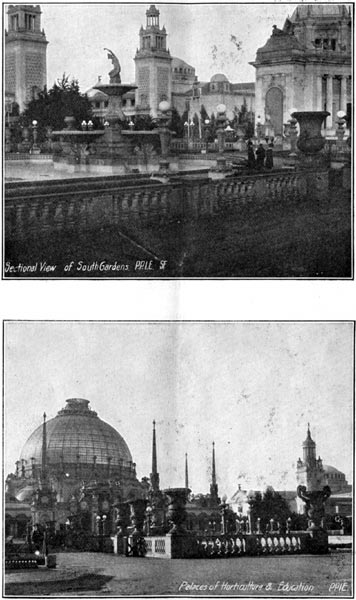 Top - Sectional View of South gradens PPIE SF Bottom - Palaces of Horticulture & Education |
|||
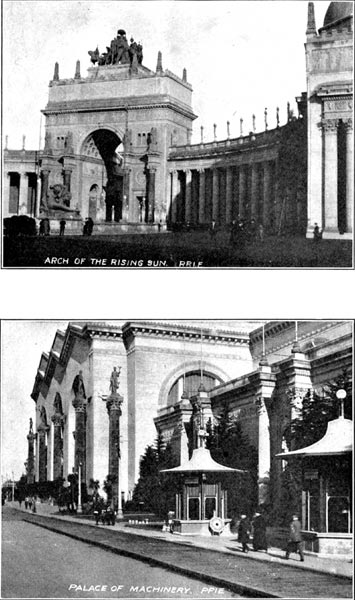 Top - Arch of the Rising Sun PPIE Bottom - Palace of Machinery PPIE |
|||
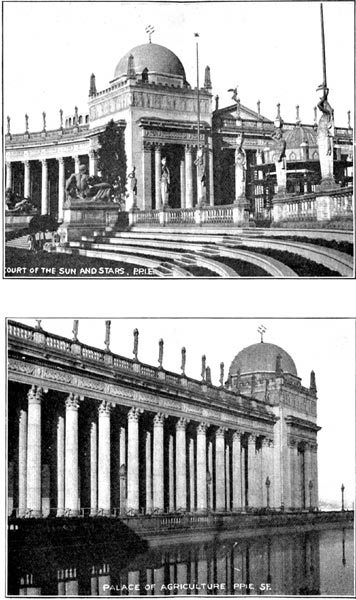 Top - Court of the Sun and Stars PPIE Bottom - Palace of Agriculture PPIE SF |
|||
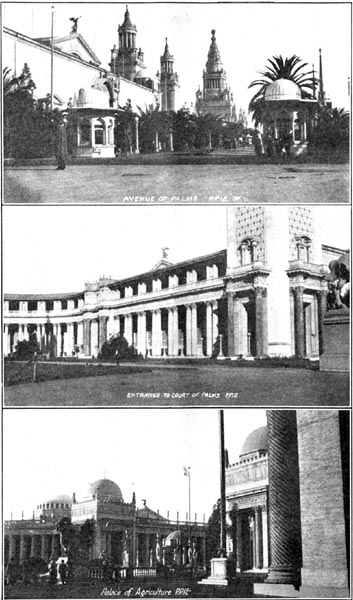 Top - Avenue of Palms PPIE SF Middle - Entrance to the Court of Palms PPIE Bottom - Palace of Agriculture PPIE |
|||
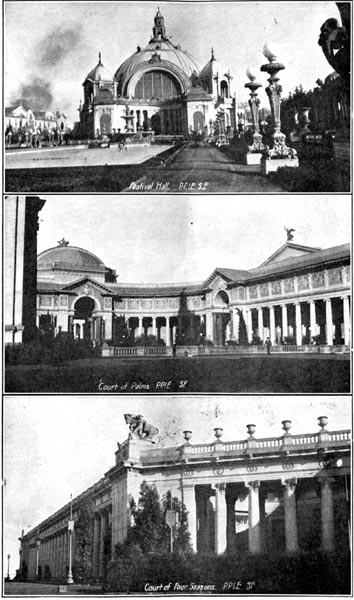 Top - Festival Hall PPIE SF Middle - Court of Palms PPIE SF Court of Four Seasons PPIE SF |
|||
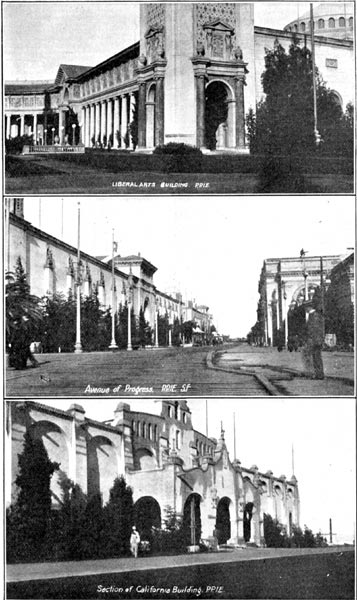 Top - Liberal Arts Building PPIE Middle - Avenue of Progress PPIE SF Section of California Building PPIE |
|||
 |
|||
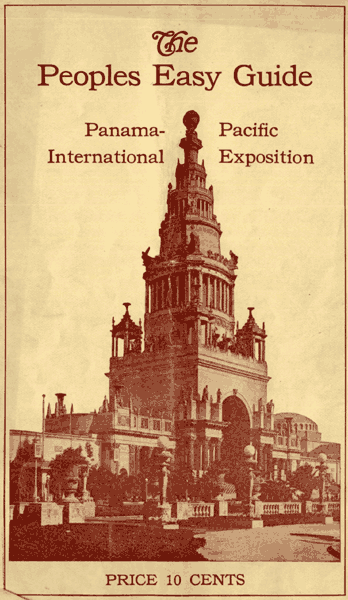 |
|||